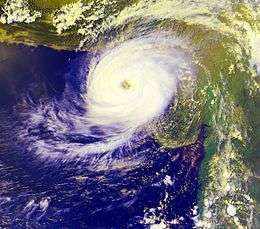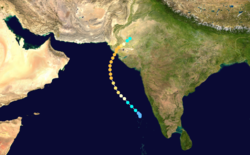1999 Pakistan cyclone
The 1999 Pakistan cyclone (Joint Typhoon Warning Center designation: 02A; India Meteorological Department designation: ARB 01) was a deadly tropical cyclone that brought further devastation to a region struck by a powerful storm nearly a year earlier.
| Extremely severe cyclonic storm (IMD scale) | |
|---|---|
| Category 3 tropical cyclone (SSHWS) | |
 Satellite image of the cyclone making landfall in Pakistan | |
| Formed | May 16, 1999 |
| Dissipated | May 22, 1999 |
| Highest winds | 3-minute sustained: 195 km/h (120 mph) 1-minute sustained: 205 km/h (125 mph) |
| Lowest pressure | 946 hPa (mbar); 27.94 inHg |
| Fatalities | 6,400 total |
| Damage | $6 million (1999 USD) |
| Areas affected | India and Pakistan |
| Part of the 1999 North Indian Ocean cyclone season | |
Meteorological history

An area of disturbed weather in the Arabian Sea was monitored in early May for possible development. Over the next two weeks, strong convection would develop before sunrise but dissipate by sunset. By May 16, the convection had become constant and a TCFA was issued at 0100Z. The low became a tropical storm by 0900Z. Tropical Storm 02A intensified as it moved to the northwest, and reached cyclone status on May 17 at 0600Z. At that time, a mid-latitude trough weakened the subtropical ridge, allowing 02A to curve into Pakistan. 02A continued to intensify and by May 19, it had reached its peak of 125 mph (205 km/h), just below Category four status on the SSHS. 02A made landfall on May 20 near Karachi, Pakistan at peak intensity. The storm began to weaken as it continued inland over the Indus River Valley on May 21, before it completely dissipated on the next day.
Impact and aftermath
India
In India, officials evacuated more than 50,000 from coastal towns and cities as a precaution.[1] However, the powerful cyclone caused relatively little damage during its passage. Moderate rainfall was recorded across Gujarat and only one person was killed. Some areas were cut off from the surrounding region after strong winds, estimated to have been between 120 and 150 km/h (75 and 93 mph) downed power lines.[2]
Pakistan
Upon striking Pakistan, officials feared the worst, with memories of the deadly 1998 Gujarat cyclone fresh in their minds. Reports released hours after the storm moved inland stated that at least 700 people were feared to be dead and at least 3,500 were thought to be missing. Hundreds of villages along the coastline were inundated by the cyclone's large storm surge and flooding rains. High winds downed power lines throughout the region, severing communication with many affected cities. In Karachi 44 mph winds lashed the city with heavy downpour. At least 70% of the rice crop was estimated to have been lost due to the cyclone.[3] Near the storm's center, wind gusts were estimated to have reached 275 km/h (171 mph).[4]
By May 23, officials in Pakistan recovered 200 bodies; 50 were found across islands of the mainland and 150 were in the Badin District.[5] During a rescue attempt, 11 Pakistani soldiers were washed away in a swift current. None of the soldiers are believed to have survived the incident. Throughout the country, damage was estimated to have exceeded $6 million.[6] By May 24, 400 bodies had been recovered but at least 6,000 more were known to be missing and believed dead. Many of these people are believed to have been swept out to sea.[7]
Following the storm's destructive landfall, hundreds of soldiers from the Pakistan army were deployed to the region. They assisted in search and rescue operations as well as relocating survivors to shelters. According to the Associated Press, the Government of Pakistan made no attempts to evacuate residents before the cyclone made landfall, likely resulting in the large number of fatalities. At least $1 million in relief funds was to be supplied by the government.[6]
Records

Upon reaching its peak intensity, the storm became the most intense cyclone ever recorded in the Arabian Sea since records began. It surpassed the record set just a year earlier by Very Severe Cyclonic Storm ARB 02 which attained winds of 160 km/h (105 mph 3-minute sustained) and a minimum pressure of 958 mbar (hPa; 28.29 inHg). Since then, the storm has been surpassed as the strongest in the region. In June 2007, Cyclone Gonu became the first Category 5 equivalent storm ever recorded in the area. Additionally, the JTWC estimated that another storm, Cyclone Phet in 2010, attained higher sustained winds than ARB 01 in 1999; however, the IMD does not support this.
References
- "Cyclone hits Pakistan". BBC News. May 20, 1999. Archived from the original on 6 June 2010. Retrieved 8 June 2010.
- Staff Writer (May 21, 1999). "Cyclone hits Gujarat, heads for Pakistan". Indian Express Newspapers. Retrieved June 8, 2010.
- Associated Press (May 22, 1999). "700 missing after Pakistan cyclone". London: The Guardian. Retrieved June 8, 2010.
- Associated Press (May 22, 1999). "700 lost in Pakistan cyclone ; Tidal waves swamp villages". Toronto Star. Retrieved June 8, 2010.
- Associated Press (May 23, 1999). "200 dead in Pakistan cyclone". Toronto Star. Retrieved June 8, 2010.
- Associated Press (May 23, 1999). "Search begins for victims, survivors of Pakistan cyclone". The Victoria Advocate. p. 14. Retrieved June 8, 2010.
- Smita P. Nordwall (May 24, 1999). "400 dead, 6,000 missing after cyclone hits southern Pakistan". USA Today. Retrieved June 8, 2010.